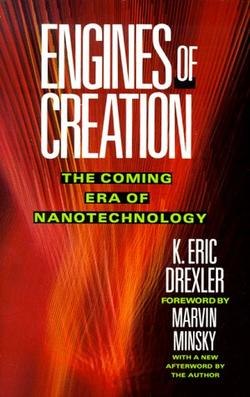Engines of Creation
From Wikipedia, the free encyclopedia
| The neutrality of this article is disputed. Please see the discussion on the talk page. Please do not remove this message until the dispute is resolved. (September 2008) |
| Engines of Creation: The Coming Era of Nanotechnology | |
 |
|
| Author | K. Eric Drexler |
|---|---|
| Publisher | Doubleday |
| Publication date | 1986 |
| ISBN | 0-385-19973-2 |
| The neutrality of this article is disputed. Please see the discussion on the talk page. Please do not remove this message until the dispute is resolved. (December 2007) |
|
Part of a series of articles on |
|
Molecular assembler |
|
See also |
Engines of Creation is a molecular nanotechnology book written by K. Eric Drexler in 1986. The foreword is by Marvin Minsky of MIT. Engines of Creation has been translated into Japanese, French, Spanish, Italian, Russian, and Chinese.[1]
Topics include hypertext as developed by Project Xanadu and life extension.
It also features nanotechnology, which Richard Feynman had discussed in his 1959 speech There's Plenty of Room at the Bottom.
Drexler wrote about a world where the entire Library of Congress fit a chip the size of a sugar cube and "universal assemblers" (tiny machines that build atom by atom) will be used for everything from medicinal robots that help clear the capillaries to environmental scrubbers that clear pollutants from the air.
Engines of Creation (Chapter 10, Limits to Growth) takes a Malthusian view of exponential growth within limits to growth. It also promotes space advocacy arguing that, because the universe is essentially infinite, life can escape the limits to growth defined by Earth. Additionally, Engines of Creation supports a form of the Fermi paradox, arguing that as there is no evidence of alien civilizations:
It is in this book Drexler first published his prediction of what might happen if a molecular nanotechnology were used to build uncontrollable self-replicating machines - the "gray goo" scenario.
With the publication of Engines of Creation Drexler founded the first group for preparing society for molecular nanotechnology. Drexler took the unusual step of securing permission from the publisher to include the post office box for the Foresight Institute, a group that did not yet exist. Drexler is no longer with the Foresight Institute.
In addition, Drexler's 1992 book, Nanosystems: molecular machinery, manufacturing, and computation, (ISBN 0-471-57518-6) is a much more technical treatment of similar material. Nanosystems addresses chemical, thermodynamic, and other constraints on nanotechnology and manufacturing.
Engines of Creation 2.0, which includes more recent papers and publications, was published as a free ebook on February 8, 2007.
[edit] Controversy
The book and the theories it presents have been the subject of some controversy. In particular, scientists such as Nobel Laureate Richard Smalley and renound Harvard chemist George M. Whitesides have been particularly critical. Smalley in particular has engaged in open debate with Drexler, attacking the views presented for what he considered both the dubious nature of the science behind them and the misleading effect on the public's view of nanotechnology. Others such as fututist Ray Kurzweil, who draws heavily on it in his own publications, have embraced the book.
For a concise list of scientific criticisms of Drexler's ideas, see physicist Richard A.L Jones' Six Challenges for Molecular Nanotechnology which would need to be overcome in order for the technology to become feasible.
[edit] External links
- Full text of version 1.0 (1986)
- Full text in Russian: МАШИНЫ СОЗДАНИЯ - Грядущая эра нанотехнологии
- Full text in Italian: MOTORI DI CREAZIONE - L'era prossima della nanotecnologia
- Full text in Chinese: 创造的发动机
- Engines of Creation 2.0 (adds follow-on papers and publications)
- Drexler's personal website and digital archive
- Biography of K. Eric Drexler
- Engines of Creation download Free Book (pdf)

